The Great Scottish Clans: History, Tartans, and Ancestral Sites
The Scottish clans, with their rich history and vibrant tartans, form the backbone of Scotland’s cultural heritage. These ancient family groups have shaped the nation’s past and continue to captivate people worldwide. This article explores the fascinating world of Scottish clans, delving into their:
- Origins and evolution
- Distinctive tartans and crests
- Ancestral lands and historic sites
From the misty Highlands to the windswept islands, clan territories once covered vast swaths of Scotland. Each clan boasted its own unique identity, forged through centuries of tradition, loyalty, and often fierce rivalry. Today, millions of people around the globe claim Scottish ancestry, fueling a renewed interest in clan history and genealogy. Whether you’re a proud clan member or simply curious about Scottish heritage, join us on a journey through time to uncover the enduring legacy of the great Scottish clans.
The Origins and Evolution of Scottish Clans
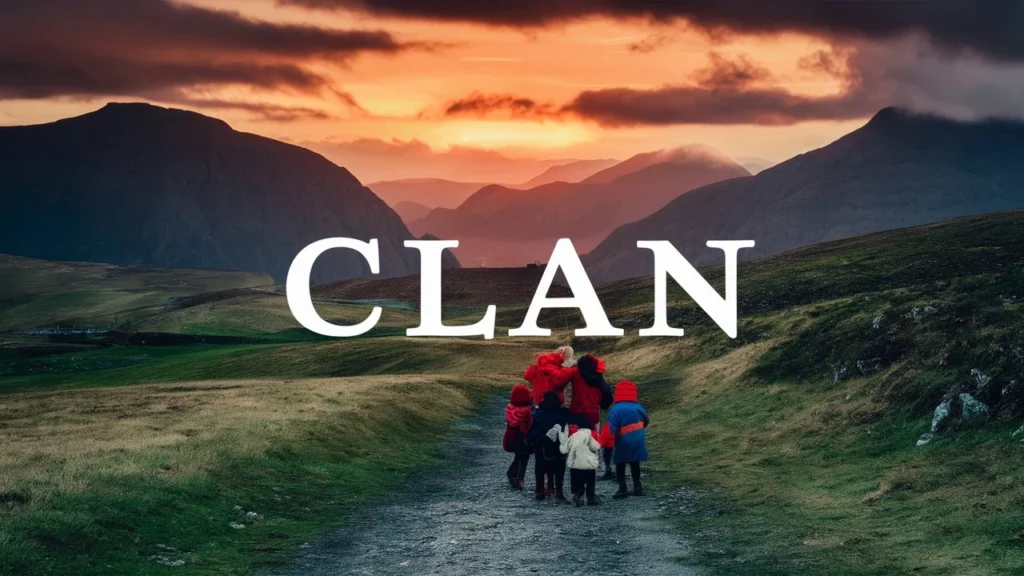
The roots of Scottish clans stretch back to ancient tribal societies, evolving over centuries into the complex social structures we recognize today. Clan, derived from the Gaelic word ‘clanna’ meaning children, emphasizes the familial bonds at the heart of these groups.
In the rugged Highland landscape, clans developed as a means of survival and protection. By the Middle Ages, the clan system had become deeply entrenched in Scottish society, particularly in the Highlands and Islands. Each clan was led by a chieftain, often claiming descent from a legendary ancestor.
The clan structure included
- The chief and his immediate family
- Clan gentry (tacksmen)
- Common clansmen and tenants
Loyalty to one’s clan was paramount, with members swearing allegiance to their chief. This devotion often led to fierce inter-clan rivalries and conflicts, shaping much of Scotland’s turbulent history.
Clans played crucial roles in:
- Local governance
- Military organization
- Land management
As centuries passed, clans adapted to changing political and economic landscapes. The clan system reached its zenith in the 16th and 17th centuries, before facing significant challenges following the Battle of Culloden in 1746 and the subsequent Highland Clearances.
Despite these upheavals, clan identities endured. Today, Scottish clans continue to evolve, embracing their heritage while adapting to the modern world. Clan societies worldwide keep traditions alive, organizing gatherings and preserving ancestral connections for future generations.
Major Scottish Clans and Their Histories
Scotland’s landscape is dotted with the legacies of numerous clans, each with its own rich history. Here, we’ll explore some of the most prominent Scottish clans:
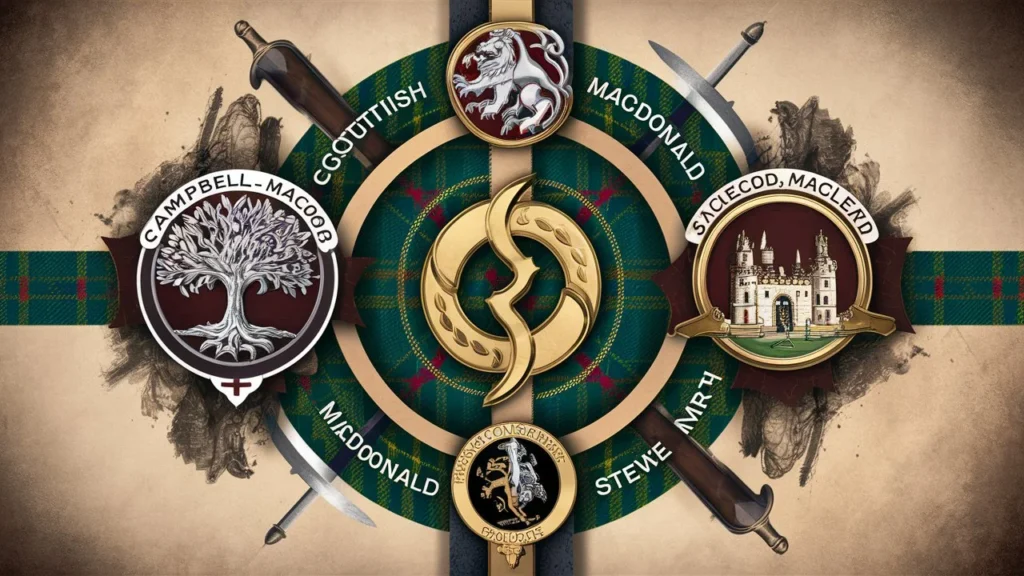
Campbell:
One of the largest and most powerful clans, the Campbells rose to prominence in the 13th century. Their motto, “Ne Obliviscaris” (Forget Not), reflects their enduring impact on Scottish history. The Campbells played key roles in:
- The Wars of Scottish Independence
- The Jacobite risings (opposing the Stuarts)
- Scottish politics, producing several Dukes of Argyll
MacDonald
Known as the “Lords of the Isles,” the MacDonalds once ruled much of Scotland’s west coast. Their power rivaled that of Scottish kings. Notable events include:
- Fierce rivalry with Clan Campbell
- Support for Bonnie Prince Charlie in the Jacobite rising of 1745
MacLeod
Hailing from the Isle of Skye, the MacLeods are famed for their ancestral home, Dunvegan Castle – the oldest continuously inhabited castle in Scotland. The clan is divided into two main branches:
- MacLeod of Harris and Dunvegan
- MacLeod of Lewis
Stewart
The royal House of Stewart provided Scotland with monarchs from 1371 to 1714. Key figures include:
- Mary, Queen of Scots
- Bonnie Prince Charlie
These clans, along with others like the MacGregors, Frasers, and Gordons, have left indelible marks on Scottish history. Their stories of valor, tragedy, and resilience continue to captivate and inspire, forming a vital part of Scotland’s cultural tapestry.
Clan Tartans That Wore The Mathieson
Tartans, the distinctive plaid patterns associated with Scottish clans, are perhaps the most recognizable symbols of clan identity. These colorful designs have a rich history and deep cultural significance.
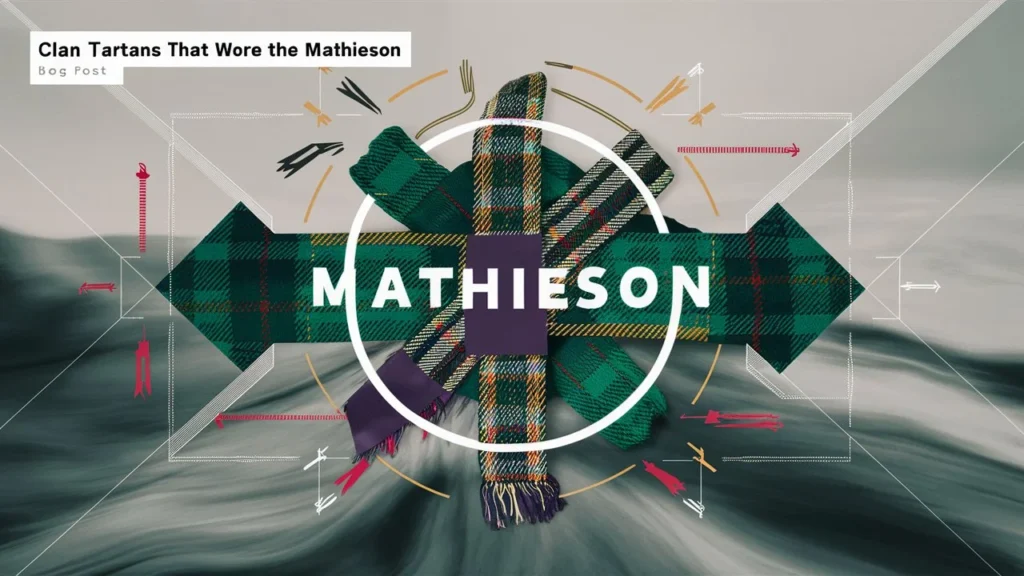
Origins
Contrary to popular belief, clan-specific tartans are a relatively recent invention. While woven plaid cloth has been used in Scotland for centuries, the idea of clan-specific patterns emerged in the late 18th and early 19th centuries. This coincided with a romantic revival of Highland culture.
Types of Tartans
- Clan tartans: The primary pattern associated with a clan
- Dress tartans: Lighter versions for formal occasions
- Hunting tartans: Darker patterns for outdoor activities
- Mourning tartans: Subdued colors for somber occasions
Significance
Tartans serve as a visual representation of clan affiliation and Scottish heritage. They play a crucial role in:
- Clan identification at gatherings
- Traditional Highland dress
- Modern fashion and design
The Great Highland Dress, featuring the kilt made from clan tartan, includes:
- Sporran (a pouch worn at the front)
- Sgian-dubh (a small knife tucked into the sock)
- Ghillie brogues (traditional shoes)
In modern times, tartans have been adopted by families, regions, and even corporations. The Scottish Register of Tartans, established in 2008, now oversees the registration and protection of tartan designs.
From kilts at weddings to tartan-patterned products, these distinctive designs continue to be a powerful symbol of Scottish identity. They connect people to their ancestral roots and showcase the enduring appeal of clan culture in the 21st century.
Clan Crests and Mottos
Clan crests and mottos are integral components of Scottish heraldry, serving as powerful symbols of clan identity and values. These emblems have deep historical roots and continue to hold significance in modern Scottish culture.
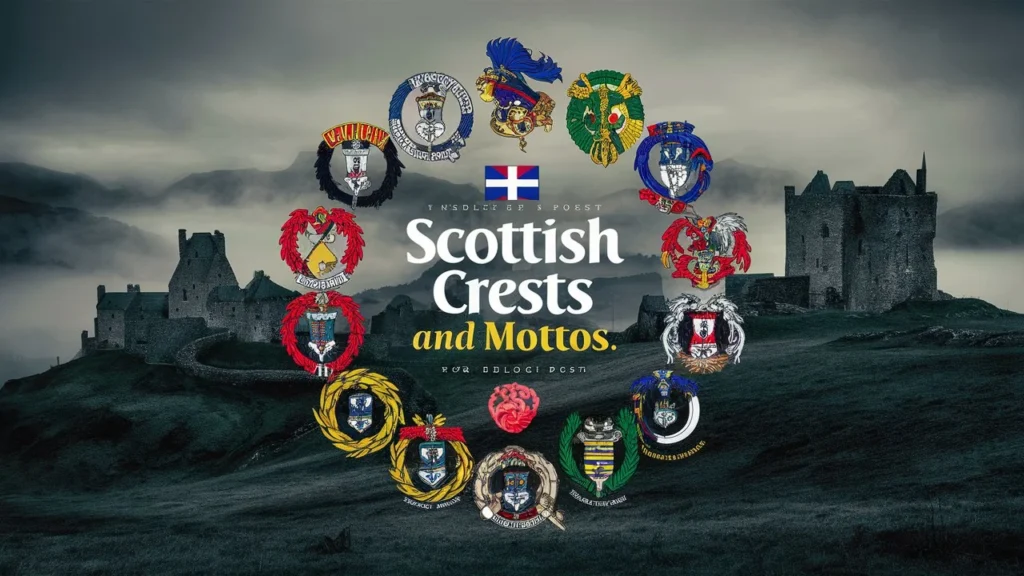
Heraldry in Clan Culture
Scottish clan heraldry dates back to medieval times. It was used to identify warriors in battle and later became a symbol of family lineage. Key elements include:
- The clan crest
- The clan motto
- The clan badge
Significance of Clan Crest
Clan crests are visual representations of a clan’s heritage and values. They typically feature:
- Animals (like lions or eagles)
- Plants (like thistles or oak trees)
- Weapons or tools
These symbols often relate to clan legends or the clan’s ancestral lands. For example, Clan MacLeod’s crest features a bull’s head, referencing a legendary strong man in their history.
Common Symbols and Meanings
- Lion: Strength and courage
- Boar: Hospitality and generosity
- Hand: Faith, sincerity, and justice
Clan Mottos: Mottos, usually in Latin or Scots Gaelic, encapsulate the clan’s ethos. For instance:
- Clan MacDonald: “Per mare per terras” (By sea and land)
- Clan Cameron: “Aonaibh Ri Chéile” (Unite)
Use in Modern Times
Today, clan crests and mottos are used in various ways:
- On clan merchandise
- At Highland Games and gatherings
- In personal jewelry and home decor
They serve as a tangible link to ancestral heritage, allowing clan members worldwide to display their connection to Scottish history and culture.
Famous Clan Battles and Conflicts
Scottish clan history is marked by numerous battles and conflicts, shaping the nation’s history and the fortunes of individual clans. These events range from inter-clan skirmishes to major battles that altered Scotland’s political landscape.

Battle of Culloden (1746)
This pivotal battle marked the end of the Jacobite rising and had far-reaching consequences for the clan system. Key points include:
- Fought between Jacobite forces (mostly Highland clans) and government troops
- Resulted in a decisive defeat for the Jacobites
- Led to the suppression of Highland culture and the clan system
Glencoe Massacre (1692)
A dark chapter in clan history, this event involved:
- Clan Campbell carrying out orders against Clan MacDonald
- Violation of Highland hospitality traditions
- Long-lasting impact on clan relations and Scottish politics
Battle of Bannockburn (1314)
While not strictly a clan battle, this conflict saw many clans unite under Robert the Bruce. It resulted in:
- A significant victory for Scottish independence
- Enhanced prestige for clans that fought alongside Bruce
Jacobite Risings
These series of uprisings (1715, 1719, 1745) saw clans divided, with some supporting the Jacobite cause and others backing the government. Notable aspects include:
- Clan rivalries influencing allegiances
- Significant battles like Prestonpans and Falkirk Muir
- Lasting impact on clan fortunes and Scottish society
Inter-clan Conflicts
Smaller-scale but often bitter feuds between clans were common, such as:
- The long-standing rivalry between Clan Campbell and Clan MacDonald
- Conflicts over land and cattle raiding
These battles and conflicts, while often tragic, form an integral part of clan lore and Scottish history. They continue to fascinate historians and clan descendants alike, offering insights into the complex dynamics of clan society and its role in shaping Scotland’s past.
Clan Ancestral Lands and Sites
Clan territories and ancestral sites are deeply intertwined with Scottish history and clan identity. These lands, often featuring imposing castles and rugged landscapes, continue to draw visitors from around the world.
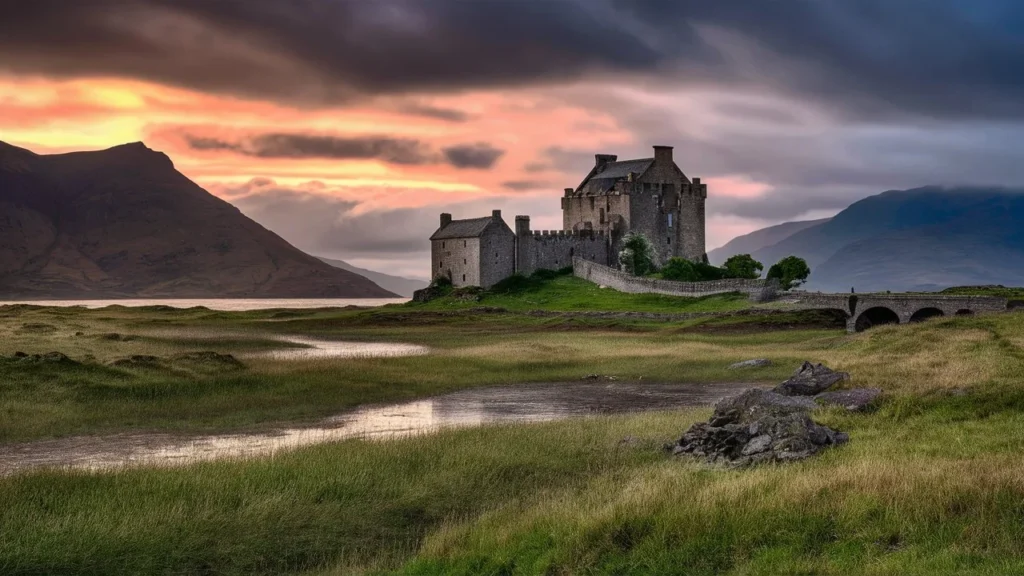
Importance of Land to Clan Identity
For centuries, clan lands were central to:
- Economic survival
- Military strength
- Clan prestige
Notable Castles and Clan Associations
- Eilean Donan Castle (Clan Macrae):
- Located in the Western Highlands
- Iconic symbol of Scotland, featured in many films
- Restored in the early 20th century
- Dunvegan Castle (Clan MacLeod):
- On the Isle of Skye
- Oldest continuously inhabited castle in Scotland
- Houses clan relics like the Fairy Flag
- Inveraray Castle (Clan Campbell):
- Seat of the Dukes of Argyll
- Blends Baroque, Palladian, and Gothic architecture
- Open to the public, showcasing clan history
Clan Seats and Gathering Places
Many clans have traditional gathering spots, often in dramatic natural settings. These include:
- Glens (valleys)
- Lochs (lakes)
- Mountain passes
Significant Battlefields and Memorial Sites
- Culloden Battlefield: Near Inverness, site of the last pitched battle on British soil
- Glencoe: Scene of the infamous massacre, now a somber memorial
Visiting these sites offers a tangible connection to clan history. Many are now managed by organizations like Historic Environment Scotland or the National Trust for Scotland, ensuring their preservation for future generations.
Modern clan gatherings often take place at these ancestral sites, allowing clan members from around the world to walk in their ancestors’ footsteps and strengthen their connection to their heritage.
The Clan System’s Decline
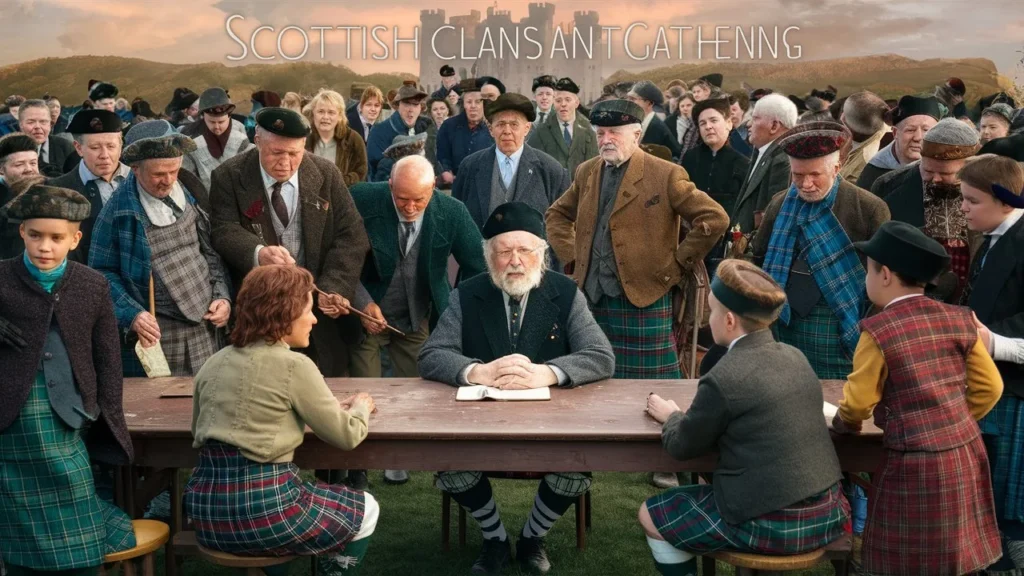
The decline of the Scottish clan system was a gradual process, influenced by various historical events and societal changes. This transformation had profound effects on Highland culture and the Scottish way of life.
Impact of the Battle of Culloden (1746)
This decisive battle led to:
- Harsh repression of Highland culture
- Banning of tartan and bagpipes
- Disarming of clan warriors
Highland Clearances
A series of forced evictions from the late 18th to 19th centuries:
- Landowners replaced people with sheep for profit
- Mass emigration of Highlanders to the Americas and Australia
- Destruction of traditional clan lands and communities
Industrialization and Urbanization
The Industrial Revolution brought significant changes:
- Migration from rural areas to cities for work
- Breakdown of traditional clan hierarchies
- Shift from agrarian to industrial economy
Changes in Land Ownership
New laws and economic pressures altered the Highland landscape:
- Clan chiefs became landlords focused on profit
- Traditional clan loyalties eroded
- Introduction of sporting estates for wealthy outsiders
Despite these challenges, clan identities persisted. Many Scots, both at home and abroad, maintained strong connections to their clan heritage. This resilience laid the groundwork for the modern revival of clan culture.
The decline of the clan system marked the end of a way of life that had existed for centuries. However, it also sparked a diaspora that spread Scottish culture worldwide, setting the stage for the global interest in Scottish heritage we see today.
Modern Revival of Clan Culture
Despite the historical decline of the clan system, recent decades have seen a significant resurgence of interest in Scottish clan culture. This revival has manifested in various ways, both in Scotland and among the Scottish diaspora worldwide.
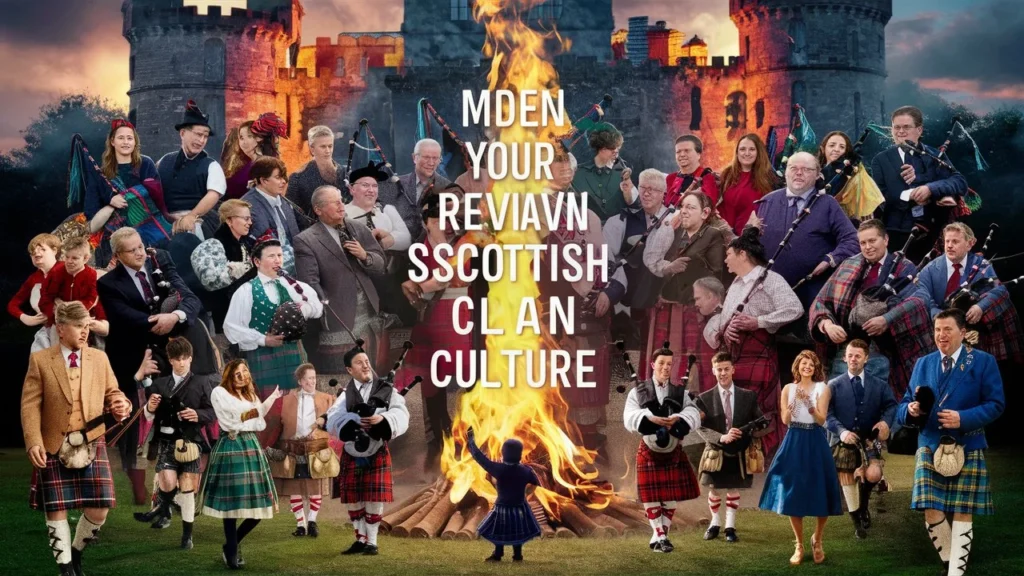
Scottish Diaspora and Heritage Tourism
- Millions worldwide claim Scottish ancestry
- Surge in genealogical research and DNA testing
- Increased tourism to clan lands and historical sites
Clan Societies and Organizations
- International clan associations maintain connections
- Regular clan gatherings and events
- Preservation of clan histories and traditions
Highland Games and Gatherings
- Celebration of Scottish culture and athleticism
- Clan tents showcase individual clan histories
- Competitions in traditional Scottish sports
Genetic Genealogy
- DNA testing helps people discover clan connections
- Challenges and confirms traditional clan affiliations
- Sparks interest in exploring Scottish roots
Use of Clan Identities in Marketing
- Clan tartans used in fashion and product design
- Whisky brands leveraging clan histories
- Tourism industry promoting clan heritage experiences
Popular Culture
- Films and TV shows featuring clan stories
- Historical novels set in clan-era Scotland
- Video games incorporating Scottish clan themes
This modern revival has breathed new life into clan culture, adapting it for the 21st century. While no longer a political or military system, clans continue to provide a sense of identity and community for many. The renewed interest ensures that Scotland’s clan heritage remains a vibrant part of global culture.
Tracing Your Scottish Clan Ancestry
The quest to uncover Scottish clan roots has become increasingly popular, driven by advances in genealogical research and DNA testing. This section explores how to embark on your own clan ancestry journey.

Getting Started
- Gather family records and oral histories
- Identify key Scottish surnames in your family tree
- Create a family tree chart to organize information
Key Resources to Trace The Clan Ancestry
- ScotlandsPeople: • Official Scottish government records site • Access to birth, marriage, and death records
- National Records of Scotland: • Archives of historical documents • Census records and parish registers
- Clan Society Databases: • Many clans maintain genealogical records • Can provide specific clan-related information
DNA Testing for Scottish Ancestry
- Autosomal DNA tests for overall ethnic makeup
- Y-DNA tests for paternal lineage
- mtDNA tests for maternal heritage
Challenges in Tracing Clan Lineages
- Limited records before the 18th century
- Name changes and variations in spelling
- Adoptions and non-paternal events
Adopting a Clan Affiliation
- Many clans welcome members with historical ties
- Some accept members based on shared surnames
- Others are open to anyone with an interest in the clan
Remember, tracing Scottish ancestry is often a complex but rewarding process. It requires patience, persistence, and a willingness to dig deep into historical records. The journey of discovery can lead to a stronger connection with your heritage and potentially new connections with clan members worldwide.
Visiting Scotland: A Clan Perspective
Exploring Scotland through the lens of clan history offers a unique and enriching travel experience. This section provides guidance for planning a clan-focused trip to Scotland.
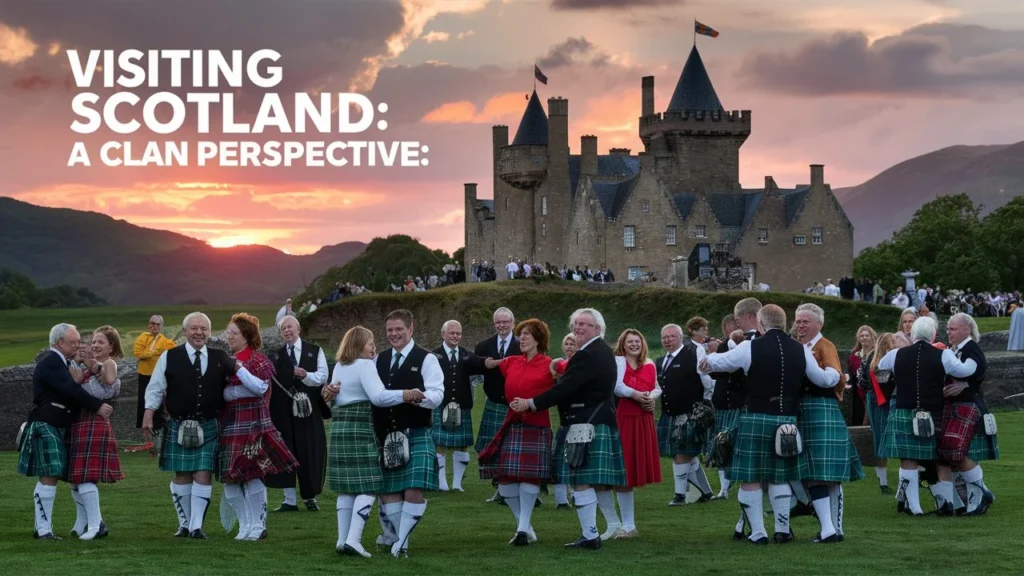
Planning a Clan-Focused Trip
- Research your clan’s ancestral lands
- Check clan society websites for events or gatherings
- Consider timing your visit during Highland Games season
Key Sites and Museums
- Culloden Battlefield and Visitor Centre: • Near Inverness • Interactive exhibits on the 1746 battle • Memorial cairn for fallen clans
- Clan Armstrong Centre: • In Langholm, Scottish Borders • Exhibits on Border clan history • Genealogical resources
- Other Notable Sites: • Scottish Clan Centre in Edinburgh • Clan Donald Centre on Isle of Skye • Various clan-specific museums across Scotland
Attending Clan Gatherings and Events
- Annual clan gatherings often held in ancestral lands
- Highland Games feature clan tents and competitions
- Local festivals may have clan-related activities
Exploring Ancestral Lands Responsibly
- Respect private property and local communities
- Follow Scotland’s outdoor access code
- Consider guided tours for deeper historical context
Practical Tips
- Book accommodations in advance, especially during peak season
- Rent a car for easier access to rural clan sites
- Learn basic Gaelic phrases for a more immersive experience
A clan-focused trip can provide a profound connection to Scottish heritage. It allows visitors to walk in their ancestors’ footsteps, experience the landscapes that shaped clan histories, and engage with living traditions that continue to thrive in modern Scotland.
The Future of Scottish Clans
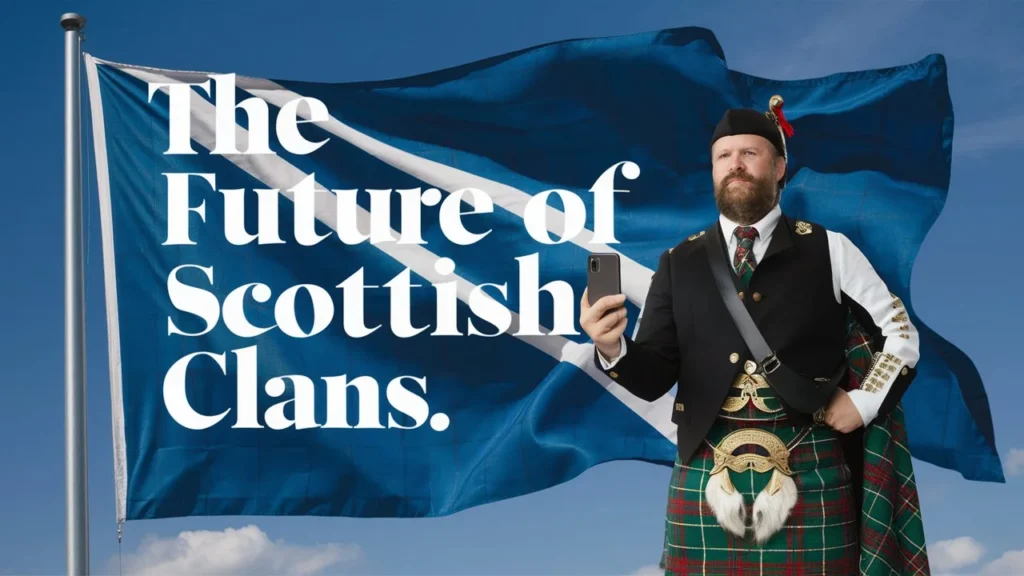
As we look ahead, Scottish clans face both challenges and opportunities in maintaining their relevance and vitality in the modern world.
Balancing Tradition and Modernity
- Preserving ancient customs while embracing new technologies
- Using social media to connect clan members globally
- Digital archives to safeguard clan histories and genealogies
Role in Contemporary Scottish Identity
- Clans as cultural ambassadors for Scotland
- Influence on Scottish tourism and economic development
- Contribution to debates on Scottish independence and devolution
Challenges
- Aging membership in some clan societies
- Maintaining interest among younger generations
- Addressing historical controversies sensitively
Opportunities
- Growing interest in heritage tourism
- Potential for educational partnerships with schools and universities
- Collaboration with environmental groups to protect clan lands
International Interest and Support
- Expanding clan societies in countries with Scottish diaspora
- Cross-cultural exchanges and international clan gatherings
- Partnerships with global Scottish heritage organizations
Adapting Clan Structures
- More inclusive membership policies
- Focus on cultural preservation rather than lineage
- Emphasis on community service and philanthropy
The future of Scottish clans lies in their ability to adapt while maintaining their core values and traditions. By embracing new technologies and ideas, clans can continue to play a vital role in preserving and promoting Scottish culture for generations to come.
As guardians of a rich heritage, clans have the potential to bridge past and present, connecting people to their roots while fostering a sense of global Scottish community.
Conclusion
The enduring legacy of Scottish clans is a testament to the resilience and richness of Scottish culture. From their ancient origins to their modern revival, clans have played a pivotal role in shaping Scotland’s history and identity.
Key points to remember
- Clans evolved from tribal societies to complex social structures
- Tartans, crests, and mottos remain powerful symbols of clan identity
- Ancestral lands and historic sites connect past and present
- The clan system’s decline led to a diaspora that spread Scottish culture globally
- Modern interest in genealogy and heritage has fueled a clan culture revival
Today, Scottish clans continue to:
- Preserve traditions and histories
- Foster connections among people of Scottish descent worldwide
- Contribute to Scotland’s cultural landscape and tourism industry
For many, exploring clan heritage offers a deeply personal journey of discovery. It provides a sense of belonging and connection to a rich historical tapestry.
Whether you’re a proud clan member or simply fascinated by Scottish history, the world of Scottish clans offers endless opportunities for learning and exploration. We invite you to delve deeper into this captivating aspect of Scottish heritage, perhaps even uncovering your own connections to the great Scottish clans.
The story of Scottish clans is not just about the past – it’s a living tradition that continues to evolve and inspire in the 21st century.

Matthew Porter is the innovative mind behind Insuranted.com, a website dedicated to providing clear, comprehensive, and reliable information on insurance. With a passion for simplifying complex topics, Matthew aims to empower readers to make informed decisions about their insurance needs










